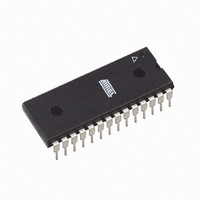ATMEGA8L-8PU Atmel, ATMEGA8L-8PU Datasheet - Page 32

ATMEGA8L-8PU
Manufacturer Part Number
ATMEGA8L-8PU
Description
IC AVR MCU 8K 8MHZ 3V 28DIP
Manufacturer
Atmel
Series
AVR® ATmegar
Datasheets
1.ATMEGA8L-8MU.pdf
(25 pages)
2.ATMEGA8L-8MU.pdf
(302 pages)
3.ATMEGA8-16PU.pdf
(305 pages)
Specifications of ATMEGA8L-8PU
Core Processor
AVR
Core Size
8-Bit
Speed
8MHz
Connectivity
I²C, SPI, UART/USART
Peripherals
Brown-out Detect/Reset, POR, PWM, WDT
Number Of I /o
23
Program Memory Size
8KB (4K x 16)
Program Memory Type
FLASH
Eeprom Size
512 x 8
Ram Size
1K x 8
Voltage - Supply (vcc/vdd)
2.7 V ~ 5.5 V
Data Converters
A/D 6x10b
Oscillator Type
Internal
Operating Temperature
-40°C ~ 85°C
Package / Case
28-DIP (0.300", 7.62mm)
Cpu Family
ATmega
Device Core
AVR
Device Core Size
8b
Frequency (max)
8MHz
Interface Type
SPI/TWI/USART
Total Internal Ram Size
1KB
# I/os (max)
23
Number Of Timers - General Purpose
3
Operating Supply Voltage (typ)
3.3/5V
Operating Supply Voltage (max)
5.5V
Operating Supply Voltage (min)
2.7V
On-chip Adc
6-chx10-bit
Instruction Set Architecture
RISC
Operating Temp Range
-40C to 85C
Operating Temperature Classification
Industrial
Mounting
Through Hole
Pin Count
28
Package Type
PDIP
Processor Series
ATMEGA8x
Core
AVR8
Data Bus Width
8 bit
Data Ram Size
1 KB
Maximum Clock Frequency
8 MHz
Number Of Programmable I/os
23
Number Of Timers
3
Operating Supply Voltage
2.7 V to 5.5 V
Maximum Operating Temperature
+ 85 C
Mounting Style
Through Hole
3rd Party Development Tools
EWAVR, EWAVR-BL
Minimum Operating Temperature
- 40 C
Controller Family/series
AVR MEGA
No. Of I/o's
23
Eeprom Memory Size
512Byte
Ram Memory Size
1KB
Cpu Speed
8MHz
Rohs Compliant
Yes
For Use With
ATSTK600-TQFP32 - STK600 SOCKET/ADAPTER 32-TQFPATSTK600-DIP40 - STK600 SOCKET/ADAPTER 40-PDIP770-1007 - ISP 4PORT ATMEL AVR MCU SPI/JTAGATAVRISP2 - PROGRAMMER AVR IN SYSTEMATSTK500 - PROGRAMMER AVR STARTER KIT
Lead Free Status / RoHS Status
Lead free / RoHS Compliant
Available stocks
Company
Part Number
Manufacturer
Quantity
Price
Company:
Part Number:
ATMEGA8L-8PU
Manufacturer:
BROADCOM
Quantity:
101
Company:
Part Number:
ATMEGA8L-8PU
Manufacturer:
ATMEL
Quantity:
33 600
Part Number:
ATMEGA8L-8PU
Manufacturer:
ATMEL/爱特梅尔
Quantity:
20 000
Company:
Part Number:
ATMEGA8L-8PU-QS096
Manufacturer:
ATMEL
Quantity:
56
Idle Mode
ADC Noise Reduction
Mode
Power-down Mode
Power-save Mode
32
ATmega8(L)
When the SM2..0 bits are written to 000, the SLEEP instruction makes the MCU enter
Idle mode, stopping the CPU but allowing SPI, USART, Analog Comparator, ADC, Two-
wire Serial Interface, Timer/Counters, Watchdog, and the interrupt system to continue
operating. This sleep mode basically halts clk
clocks to run.
Idle mode enables the MCU to wake up from external triggered interrupts as well as
internal ones like the Timer Overflow and USART Transmit Complete interrupts. If
wake-up from the Analog Comparator interrupt is not required, the Analog Comparator
can be powered down by setting the ACD bit in the Analog Comparator Control and Sta-
tus Register – ACSR. This will reduce power consumption in Idle mode. If the ADC is
enabled, a conversion starts automatically when this mode is entered.
When the SM2..0 bits are written to 001, the SLEEP instruction makes the MCU enter
ADC Noise Reduction mode, stopping the CPU but allowing the ADC, the external
interrupts, the Two-wire Serial Interface address watch, Timer/Counter2 and the
Watchdog to continue operating (if enabled). This sleep mode basically halts clk
clk
This improves the noise environment for the ADC, enabling higher resolution measure-
ments. If the ADC is enabled, a conversion starts automatically when this mode is
entered. Apart form the ADC Conversion Complete interrupt, only an External Reset, a
Watchdog Reset, a Brown-out Reset, a Two-wire Serial Interface address match inter-
rupt, a Timer/Counter2 interrupt, an SPM/EEPROM ready interrupt, or an external level
interrupt on INT0 or INT1, can wake up the MCU from ADC Noise Reduction mode.
When the SM2..0 bits are written to 010, the SLEEP instruction makes the MCU enter
Power-down mode. In this mode, the External Oscillator is stopped, while the external
interrupts, the Two-wire Serial Interface address watch, and the Watchdog continue
operating (if enabled). Only an External Reset, a Watchdog Reset, a Brown-out Reset, a
Two-wire Serial Interface address match interrupt, or an external level interrupt on INT0
or INT1, can wake up the MCU. This sleep mode basically halts all generated clocks,
allowing operation of asynchronous modules only.
Note that if a level triggered interrupt is used for wake-up from Power-down mode, the
changed level must be held for some time to wake up the MCU. Refer to “External Inter-
rupts” on page 64 for details.
When waking up from Power-down mode, there is a delay from the wake-up condition
occurs until the wake-up becomes effective. This allows the clock to restart and become
stable after having been stopped. The wake-up period is defined by the same CKSEL
Fuses that define the Reset Time-out period, as described in “Clock Sources” on page
24.
When the SM2..0 bits are written to 011, the SLEEP instruction makes the MCU enter
Power-save mode. This mode is identical to Power-down, with one exception:
If the asynchronous timer is NOT clocked asynchronously, Power-down mode is recom-
mended instead of Power-save mode because the contents of the registers in the
CPU
If Timer/Counter2 is clocked asynchronously, i.e. the AS2 bit in ASSR is set,
Timer/Counter2 will run during sleep. The device can wake up from either Timer
Overflow or Output Compare event from Timer/Counter2 if the corresponding
Timer/Counter2 interrupt enable bits are set in TIMSK, and the global interrupt
enable bit in SREG is set.
, and clk
FLASH
, while allowing the other clocks to run.
CPU
and clk
FLASH
, while allowing the other
2486O–AVR–10/04
I/O
,

















